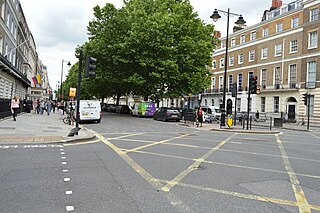
Jermyn Street is a one-way street in the St James's area of the City of Westminster in London, England. It is to the south of, parallel, and adjacent to Piccadilly. Jermyn Street is known as a street for gentlemen's-clothing retailers in the West End.

Broadwick Street is a street in Soho, City of Westminster, London. It runs for 0.18 miles (0.29 km) approximately west–east between Marshall Street and Wardour Street, crossing Berwick Street. The street extends across four separate estates, Colman Hedge Close, Little Gelding's, Pawlett's Garden and Pesthouse.

The Vere Street Coterie was a group of men arrested at a molly house in Vere Street, London in 1810 for sodomy and attempted sodomy. Eight men were eventually convicted. Two of them were hanged and six were pilloried for this offence. Along with Oscar Wilde's imprisonment for a similar offence, this episode was one of the major events in gay history in England during the 19th century.

South Molton is a town and civil parish in the North Devon district, in the county of Devon, England. The town is on the River Mole. In 2021 it had a population of 6225.

Ebury Street is a street in Belgravia, City of Westminster, London. It runs from a Grosvenor Gardens junction south-westwards to Pimlico Road. It was built mostly in the period 1815 to 1860.

St George's Fields are a former burial ground of St George's, Hanover Square, lying between Connaught Street and Bayswater Road in Tyburnia deconsecrated and sold off by the Church Commissioners in the 1970s to be built upon by The Utopian Housing Association, a housing trust.

St. Matthew Friday Street was a church in the City of London located on Friday Street, off Cheapside. Recorded since the 13th century, the church was destroyed in the Great Fire of 1666, then rebuilt by the office of Sir Christopher Wren. The rebuilt church was demolished in 1885.

St Mildred, Poultry, was a parish church in the Cheap ward of the City of London dedicated to Anglo-Saxon Saint Mildred. It was rebuilt after the Great Fire of London, and demolished in 1872. St Mildred in the Poultry was the burial place of the writer Thomas Tusser. Some description of the church and its monuments is given in John Stow's Survey of London.

St Mary Colechurch was a parish church in the City of London destroyed in the Great Fire of London in 1666 and not rebuilt.

St James Duke's Place was an Anglican parish church in the Aldgate ward of the City of London It was established in the early 17th century, rebuilt in 1727 and closed and demolished in 1874.

Cadogan Square is a residential square in Knightsbridge, London, that was named after Earl Cadogan. Whilst it is mainly a residential area, some of the properties are used for diplomatic and educational purposes.

St Martin Pomeroy was a parish church in the Cheap ward of the City of London. It was also known as St Martin Ironmonger Lane.
Marks & Co was an antiquarian bookshop at 84 Charing Cross Road, London.
Browns is a London, England-based fashion boutique founded by Joan Burstein and husband Sidney in 1970. The flagship store was previously located on South Molton Street before moving to Brook Street in May 2021. In 2015, Browns was acquired by the Portuguese online fashion company Farfetch.
Mayfair Recording Studios was a recording studio in London, England, which was in operation from the 1960s until 2008.

Portland Place is a street in the Marylebone district of central London. Named after the 3rd Duke of Portland, the unusually wide street is home to the BBC's headquarters Broadcasting House, the Chinese and Polish embassies, the Royal Institute of British Architects and numerous residential mansion blocks.

Camberwell Grove is a residential street in Camberwell, London, England, in the Borough of Southwark. It follows the line of a grove of trees, hence the name. The street once led from a Tudor manor house south to the top of a hill, which afforded a view of the City of London, approximately three miles to the north. Today, the grove is part of Camberwell Grove Conservation area.

The Grosvenor Gallery Library was a circulating library in London in the late 19th century. It was affiliated with the Grosvenor Gallery of art on Bond Street, later moving to South Molton Street. It offered subscribers current periodicals, new books, and a Ladies' Reading Room. Owners and staff included Miss Brinstingl, Coutts Lindsay, Mrs. A.W. Pollard, and Thomas Verrinder.

St Christopher's Place is a short pedestrianised shopping street in Marylebone, central London between Oxford Street and Wigmore Street. Its retail units are smaller and higher-end than the major chains located on Oxford Street, similar to nearby South Molton Street.

Mount Street is an east–west, quite narrow, archetypal street in the Mayfair district of the City of Westminster, London fronted by many mid-rise buildings, mostly of a narrow frontage. The sides of two very grand hotels flank part of either end of the street. Small, high-end property businesses, investment funds and accountancy businesses punctuate the buildings as well as a row of traditional businesses and conversion-style mansion block apartments or, more generally, authentic such homes.

















